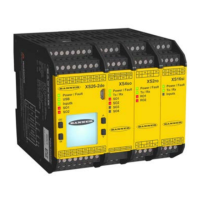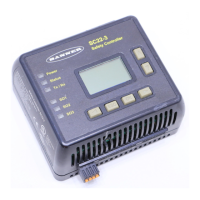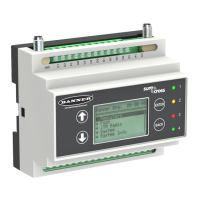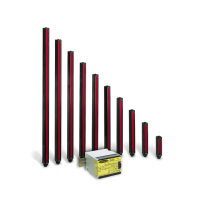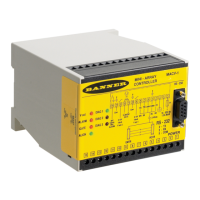P/N 69761 rev. B 29
Banner Engineering Corp. • Minneapolis, U.S.A.
www.bannerengineering.com • Tel: 763.544.3164
PICO-GUARD Controller
Instruction Manual
5. Troubleshooting and Maintenance
WARNING . . . Shut Down Machinery
Before Servicing
The machinery connected to the PICO-GUARD
System must not be operating at any time
during this procedure. Some servicing procedures may
involve working close to the hazardous areas of the
guarded machine.
Serious bodily injury or death could result.
CAUTION . . .
Electrical Danger
Exercise care whenever troubleshooting,
repairing, or modifying the PICO-GUARD
System and/or the machine control system.
Always disconnect all power from the PICO-GUARD
System and the guarded machine before making any wire
connections or before replacing any component.
Electrical connections or repairs should be done only by a
Qualified Person (see Section 3.2).
WARNING . . . Power Failures and Lockouts
A lockout is a definite indication of a problem
and should be investigated at once, by a
Qualified Person.
Attempts to continue to operate machinery by bypassing
the PICO-GUARD System are dangerous and could result in
serious bodily injury or death.
Evaluate status indicators per Section 4.4.
5.1 Troubleshooting Lockout Conditions
A lockout condition causes all of the PICO-GUARD OSSD
outputs to turn or remain OFF, sending a “stop” signal to
the guarded machine. The controller provides diagnostic
information via the status indicators or error codes via the
RS-232 terminals of the Remote Interface (see Section 4.6) to
assist in the identification of the cause(s) of lockouts.
A lockout condition is indicated by the System Status indicator
Flashing Red (All errors). Figure 5.1 provides information
regarding error identification, error description and appropriate
action.
To recover from a Lockout condition (except USSI input errors),
correct all errors and perform a system reset. See Section 4.3
for reset procedures.
For USSI input errors, lockout recovery is accomplished per
the following:
1. Identify and correct the cause of the error (see Figure 5.1).
2. Cycle the external stop device connected to the USSI
input (closed/ON and then open/OFF). Both channels of
the external stop device must open (or go OFF) within 3
seconds of each other.
NOTE for USSI 1 errors: After lockout recovery, a USSI 1 reset
is required when both channels go closed/ON.
5.2 Electrical and Optical Noise
The PICO-GUARD System is designed and manufactured to be
highly resistant to electrical and optical noise and to operate
reliably in industrial settings. However, serious electrical and/or
optical noise may cause a random Trip or Latch condition. In
very extreme electrical noise cases, a lockout is possible. In
order to minimize the effects of transitory noise, the PICO-
GUARD System will respond to noise only if the noise is
detected on multiple consecutive scans.
If random nuisance trips occur, check the following:
• Loose or intermittent electrical wire or fiber optic
connections;
• Optical interference from adjacent photoelectric devices; or
• Controller input or output wires routed too close to “noisy”
wiring.
Monitoring for presence of noise: The PICO-GUARD system
will, in many cases, indicate the presence of electrical or
optical noise by flashing the appropriate controller indicators
with a flashing burst (three short consecutive flashes).
For instance; if noise is detected on Channel 1, a flashing burst
will appear on the Channel 1 indicator. Noise is indicated in
a similar fashion for the other channel and input indicators
(see Section 4.4). In addition to the controller indicators, the
RS-232 diagnostic data of the Remote Interface output can
provide information regarding noise detection (see Section
4.6). The noise path can be identified and the noise source can
be found most quickly by monitoring the controller indicators
or the RS-232 diagnostic output.
Checking for sources of electrical noise: All PICO-GUARD
System wiring is low voltage; running these wires alongside
power wires, motor/servo wires, or other high-voltage wiring
can inject noise into the PICO-GUARD System. It is good
wiring practice (and may be required by code) to isolate PICO-
GUARD System wires from high-voltage wires.
Troubleshooting and Maintenance
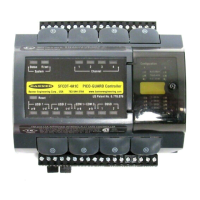
